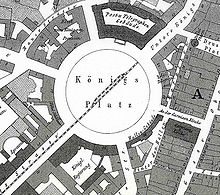Palais Hessen-Rotenburg (Kassel)
Coordinates: 51 ° 18 ′ 54 ″ N , 9 ° 29 ′ 50 ″ E
The Palais Hessen-Rotenburg in Kassel , North Hesse, was the city residence of the paraged Landgraves of Hessen-Rotenburg , who ruled the partially independent Landgrave of Hessen-Rotenburg from 1629.
The construction
The elegant monumental building stood at the southeast corner of the confluence of Obere Königsstraße with Königsplatz, which was conceived in 1767 by the architect and town planner Simon Louis du Ry as part of the redesign of the city . The three- story palace was built in 1767–1769 by the architect Christoph Philipp Diede on behalf of Landgrave Konstantin von Hessen-Rotenburg . The main front was on Königsstrasse. A small five-axis side wing on Königsplatz was originally an independent building and was only connected to the main building with a very narrow connecting piece. A hierarchical basement division with a piano nobile reported first floor coined the rococo facade. The building enjoyed a high level of acceptance among the city's population due to its attractive facade with its ornamental details, which were referred to as the “Parisian style”.
history
After the French occupation of Kurhessen in 1806 and the creation of the Kingdom of Westphalia in August 1807 and the entry of the new King of Westphalia, Napoleon's brother Jérôme , into Kassel in December 1807, the last Landgrave of Hessen-Rotenburg, Victor Amadeus , was forced to to leave the Palais Rotenburg in Kassel to pay off a sum of 35,000 thalers owed to the expelled elector and now claimed by Jérôme . He had refused his unsolicited appointment as royal chamberlain and was then accused by Jérôme of felonia . Only after the handover of the palace did Jérôme confirm him as Prince on July 10, 1813.
After the restitution of Kurhessen in 1813, the palace came into the possession of the Kurhessischen state, which used it as an administrative building. In the period around 1822–1833, the side wing facing Königsplatz was extended to the confluence with Karlsstrasse and to the rear of the then state ministerial building. Since the building site did not allow the new Königsplatz wing to be erected as a solid structure over ten axes , the extension was carried out in plastered framework . Since the 1830s, the entire Ministry of the Electorate of Hesse had its seat in the palace and its annexes. After the annexation of Kurhessen by Prussia in 1866, the palace served from October 1867 to 1882 as the official building of the Royal Prussian Government in Cassel, the forerunner of the later regional council.
The building was subsequently used as a municipal cash building for a long time. A new town hall for Kassel was planned on this property for a long time. But then, on September 26, 1910, the Hessische Bankverein, founded in 1908, bought the Palais Hessen-Rotenburg from the city of Kassel. The construction was canceled the next year except for the basement, and a bank and commercial building was built in its place from 1911–1912, today's Commerzbank-Haus (Obere Königsstrasse 32–34). It is now the oldest building on Königsplatz.
The urban development connection of the Palais Hessen-Rotenburg with the White Palais on Friedrichsplatz was established by the Palais Reichenbach , built in 1772 , which was originally called Palais Gohr after its client.
literature
- Ernst Christopher Metz : Royal seat of Cassel. Friedrich Lometsch-Verlag, Kassel, 1980
- Karl Hermann Wegner: Pictures from the old Kassel. Paintings and graphics 1870 - 1940. Sources and perspectives on the development of Kassel, Vol. 4. Ed. Association Friends of the City Museum, Kassel, 1995, p. 77
Web links
- Painting: Königsplatz, by F. Fennel. From: Karl Hermann Wegner, Pictures from the old Kassel (1995), p.77 (the palace can be seen on the left)
- “View of Königsplatz with Königsstrasse, around 1860” (on the left the Palais Hessen-Rotenburg). Historical town views, plans and floor plans. In: Landesgeschichtliches Informationssystem Hessen (LAGIS).
- Demolition of the Palais Reichenbach, 2006 (with the floor plan of the Palais Hessen-Rotenburg)
- Regional Council Kassel: The history of our building
- Kassel, State Museums, Graphic Collection: Kassel, Palais Hessen-Rotenburg, Königsplatz wing and Königsstrasse wing, elevation and section
Notes and individual references
- ↑ Victor Amadeus still refused to enter the service of Jérôme.
- ↑ In 1882 they moved into a huge new building in the Wilhelminian style on the site of the former city palace .


